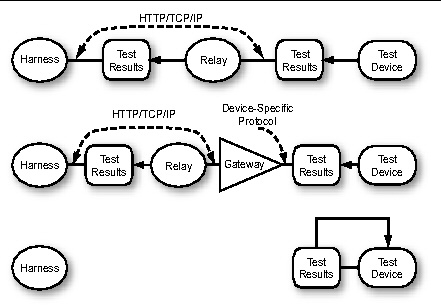| C H A P T E R 4 |
|
Test Device Requirements and Connection Options |
The Java Device Test Suite can work with many types of test devices. This chapter describes the device requirements and the options for connecting devices with the harness so tests can run and results can be inspected.
This chapter includes the following sections:
Test devices must meet these requirements:
In addition to the requirements listed in Test Device Requirements, a test device must support at least one of the connection options described in this section. The connection options support the transfer of tests and results:
When a tester directs the harness to run tests, the harness packs groups of tests into MIDP MIDlet suites, which are called test bundles. To run the tests in a bundle, the bundle must be transferred to the test device, installed, and launched. The bundles can be transferred by HTTP or over a local link, such as a serial cable. You specify your choice in the Tests and Bundles section of a template or configuration. The procedures for installing and launching a bundle are device dependent.
When test bundles are transferred by HTTP, the harness repeatedly creates test bundles and sends them to the Relay. The tester (typically) downloads a bundle from the Relay, installs it and launches it, which causes the tests to run.
The Relay can transfer test bundles over a TCP/IP connection that supports HTTP version 1.0 or 1.1. The device itself does not need to support HTTP over TCP/IP if “bridge” hardware or software between the test device and the Relay can act as an HTTP client on behalf of the device. A WAP gateway is one example of such a bridge. FIGURE 4-1 illustrates HTTP test bundle downloading to a device that supports HTTP over TCP/IP and to a device that requires a bridge.
FIGURE 4-1 Test Bundle Transfer Options - HTTP

The alternative to HTTP bundle transfer is to use a local link, such as serial, infrared, or Bluetooth. This option requires cooperating software on the harness host, or another host. In the configuration, you specify a directory into which the harness stores the test bundles. You direct the software to download the test bundles from the directory to the test device. FIGURE 4-2 illustrates test bundle transfer by a local link.
FIGURE 4-2 Test Bundle Transfer - Local Link

FIGURE 4-3 illustrates the options for handling test results. For test results to be transferred from a test device to a harness, the test device’s Java environment, or a gateway interposed between the device and the Relay, must support HTTP version 1.0 or 1.1 over TCP/IP. If the test device or gateway does not support HTTP, test results are not sent to the harness. Instead, test results can be displayed on the device. You specify your choice in the Tests and Bundles section of a template or configuration.
FIGURE 4-3 Test Result Disposition Options
